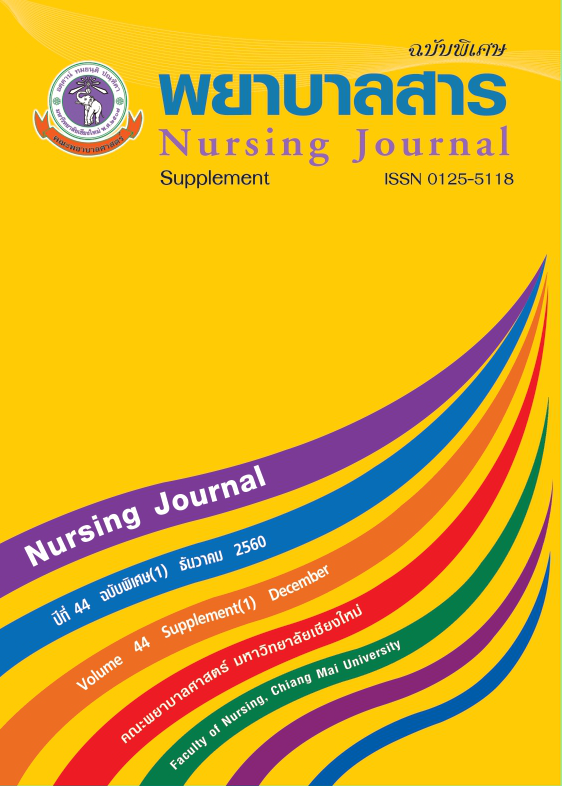Factors Predicting Health Behaviors Among Persons with Acute Myeloblastic Leukemia Receiving Chemotherapy
Keywords:
Factors predicting, health behaviors, leukemia, acute myeloblastic leukemia, chemotherapyAbstract
Persons with acute myeloblastic leukemia receiving chemotherapy should have appropriate health behaviors to prevent complications in their treatment. The purposes of this predictive study were therefore to describe levels of health behaviors among persons with acute myeloblastic leukemia receiving chemotherapy and to explore the predicting factors of perceived benefits, perceived barriers, perceived self-efficacy, and social support. The Health Promotion Model by Pender (2006) was adopted as the conceptual framework for this study. The subjects were 75 persons with acute myeloblastic leukemia receiving chemotherapy and attending the hematology clinic outpatient unit of Maharaj Nakorn Chiang Mai Hospital, from February to May 2014. Subjects were selected by purposive sampling. The research instruments consisted of a demographic data recording form and questionnaires regarding health behaviors, perception of benefits, barriers, self-efficacy of health behaviors, and perception of social support among the sample group. Data were analyzed by descriptive statistics and stepwise multiple regression.
The results of this study revealed that:
- Subjects had moderate levels of overall health behaviors. Considering each aspect, the study demonstrated that behaviors regarding infection prevention, lessening of nausea and vomiting symptoms, and stress management, were at moderate levels. Bleeding prevention and behaviors done during anemia were however at high levels.
- Perceived self-efficacy was the only factor predicting health behaviors among persons with acute myeloblastic leukemia receiving chemotherapy and accounted for 20.9% (p<.001).
The results of this study demonstrated that perceived self-efficacy could predict health behaviors among persons with acute myeloblastic leukemia receiving chemotherapy. Therefore, self-efficacy of this population should be developed to enhance results for better nursing outcomes.
References
พิจิตรา เล็กดำรงกุล, คนึงนิจ พงศ์ถาวรกมล, ชูชื่น ชีวพูนผล, และ นภดล ศิริธนารัตนกุล. (2552). ปัจจัยที่เกี่ยวข้องกับการเกิดไข้ในภาวะเม็ดเลือดขาวต่ำในผู้ป่วยโรคมะเร็งเม็ดเลือดขาวชนิดเฉียบพลันที่ได้รับยาเคมีบำบัด. วารสารพยาบาลศาสตร์, 27(2), 58-68.
วราพร คุ้มอรุณรัตนกุล, อัครอนงค์ ปราโมช, และ ศิริรัตน์ ปานอุทัย. (2548). ปัจจัยทำนายพฤติกรรมส่งเสริมสุขภาพในผู้สูงอายุโรคปอดอุดกั้นเรื้อรัง. พยาบาลสาร, 32(4), 84-98.
วีระศักดิ์ นาวารวงศ์. (2550). มะเร็งเม็ดเลือดขาวเฉียบพลันชนิดไมอิลอยด์. ใน วิชัย ประยูรวิวัฒน์, แสงสุรีย์ จูฑา, และ ถนอมศรี ศรีชัยกุล. (บรรณาธิการ), ตำราโลหิตวิทยา: การวินิจฉัยและการรักษาโรคเลือดที่พบบ่อยในประเทศไทย (พิมพ์ครั้งที่ 3, หน้า 331-359). กรุงเทพฯ: นำอักษรการพิมพ์.
สำนักนโยบายและยุทธศาสตร์ สำนักงานปลัดกระทรวงสาธารณสุข. (2553). สถิติสาธารณสุข. กรุงเทพฯ: กระทรวงสาธารณสุข.
สำนักนโยบายและยุทธศาสตร์ สำนักงานปลัดกระทรวงสาธารณสุข. (2554). สถิติสาธารณสุข. กรุงเทพฯ: กระทรวงสาธารณสุข.
สำนักนโยบายและยุทธศาสตร์ สำนักงานปลัดกระทรวงสาธารณสุข. (2555). สถิติสาธารณสุข. กรุงเทพฯ: กระทรวงสาธารณสุข.
หทัยรัตน์ เวชมนัส, ศิริรัตน์ ปานอุทัย, และ อัครอนงค์ ปราโมช. (2548). ปัจจัยทำนายพฤติกรรมส่งเสริมสุขภาพในผู้สูงอายุที่มีภาวะหัวใจวาย. พยาบาลสาร, 32(4), 99-113.
หฤทัย พุทธิเสาวภาคย์. (2547). ปัจจัยทำนายพฤติกรรมส่งเสริมสุขภาพในผู้สูงอายุโรคมะเร็งปอด(วิทยานิพนธ์พยาบาลศาสตรมหาบัณฑิต สาขาวิชาการพยาบาลผู้สูงอายุ). บัณฑิตวิทยาลัย, มหาวิทยาลัยเชียงใหม่.
อิศรางค์ นุชประยูร. (2547). Chemotherapy for leukemia. ใน พรเทพ เทียนสิวากุล (บรรณาธิการ), โลหิตวิทยาคลินิกชั้นสูง (หน้า 144-168). กรุงเทพฯ: จุฬาลงกรณ์มหาวิทยาลัย.
American Cancer Society. (2005). Cancer facts& figures 2005. Retrieved from http://www.cancer.org
American Cancer Society. (2011). Understanding chemotherapy: A guide for patients and family. Retrieved from http://www.cancer.org
American Cancer Society. (2013). Nausea and vomiting. Retrieved from http://www.cancer.org
American Cancer Society. (2014). Cancer facts& figures 2014. Retrieved from http://www.cancer.org
Bandura, A. (1997). Self-efficacy: The exercise of control. New York: W. H. Freeman.
Gobel, B. H., & O’Leary, C. (2007). Bone marrow suppression. In M. E. Langhorne, J. S. Fulton, & S. E. Otto (Eds.), Oncology nursing (5th ed., pp. 488-504). St. Louis: Mosby Elsevier.
Gupta, A., Singh, M., Singh, H., Kumar, L., Sharma, A., Bakhshi, S., . . . Thulkar, S. (2010). Infections in acute myeloid leukemia: An analysis of 382 febrile episodes. Medical Oncology, 27(4), 1037-1045. doi: 10.1007/s12032-009-9330-9
House, J. S. (1981). Work stress and social support. New Jersey: Prentice Hall.
Johnson, E., Gilmore, M., Newman, J. & Stephens, M. (2000). Preventing fungal infections in immunocompromised patients. British Journal of Nursing, 9(17), 1154-1156, 1158-1164.
Kleinman, L., Benjamin, K., Viswanathan, H., Mattera, M. S., Bosserman, L., Blayney, D. W., &Revicki, D. A. (2012). The anemia impact measure (AIM): Development and content validation of a patient-reported outcome measure of anemia symptoms and symptom impacts in cancer patients receiving chemotherapy. Quality of Life Research, 21(7), 1256-1266. doi:10.1007/s11136-001-0034-1
Miller, K. B., & Daoust, P. R. (2005). Clinical manifestations of acute myeloid leukemia. In R. Hoffman, E. J. Benz, Jr., S. J. Shattil, B. Furie, H. J. Cohen, & L. E. Silberstein (Eds.), Hematology basic principles and practice (4th ed., pp. 1071-1074). Philadelphia: Elsevier.
National Cancer Institute. (2012). Oral complications of chemotherapy and head/neck radiation. Retrieved from web site: http://www.cancer.gov/cancertopics/pdg/supportivecare/ oralcomplications
Pender, N. J. (2006). Health promotion in nursing practice (5th ed.). New Jersey: Upper Saddle River.
Translated Thai References
Boonjai Srisatidnarakul. (2007). The methodology in nursing research (4th ed., pp. 459). Bangkok: U & I Intermedia.
Pichitra Lekdamrongkul, Kanaungnit Pongthavornkamol, Chuchuen Chewapoonpon, and Noppadol Siritanaratkul. (2009). Factors associated with febrile neutropenia in acute leukemic patients receiving chemotherapy. Journal of Nursing Science, 27(2), 58-68.
Varaporn Komaroonrutanakul, Akanong Pramoch, and Sirirat Panuthai. (2005). Factors predicting health promoting behaviors among the elderly with coronary artery disease. Nursing Journal, 32(4), 84-98.
Weerasak nawarawong. (2007). Acute Myeloid Leukemia. In Wichai Prayoonwiwat, Saengsuree Jootar, and Thanomsri Srichaikul. (Eds.), Hematology: Clinical principles and applications in Thailand (3rd ed., pp. 331-359). Bangkok: Nam akson printing house.
Bureau of policy and strategy, office of the permanent secretary. (2010). Public health statistics. Bangkok: Ministry of public health.
Bureau of policy and strategy, office of the permanent secretary. (2011). Public health statistics. Bangkok: Ministry of public health.
Bureau of policy and strategy, office of the permanent secretary. (2012). Public health statistics. Bangkok: Ministry of public health.
Hathairat Wetmanut, Sirirat Panuthai, and Akanong Pramoch. (2005). Factors predicting health promoting behaviors among the elderly with heart failure. Nursing Journal, 32(4), 99-113.
Haruthai Puttisoawwapak. (2004). Factors predicting health behaviors among the elderly with lung cancer (Master of nursing science thesis, gerontological nursing). Graduate school, Chiang Mai University.
Issarang Nuchprayoon. (2004). Chemotherapy for leukemia. In Pornthep Tiensiwakul (Eds.), Advanced clinical hematology (pp. 144-168). Bangkok: Chulalongkorn University.
Downloads
Published
How to Cite
Issue
Section
License
บทความที่ได้รับการตีพิมพ์เป็นลิขสิทธิ์ของวารสารพยาบาลสาร
ข้อความที่ปรากฏในบทความแต่ละเรื่องในวารสารวิชาการเล่มนี้เป็นความคิดเห็นส่วนตัวของผู้เขียนแต่ละท่านไม่เกี่ยวข้องกับมหาวิทยาลัยเชียงใหม่ และคณาจารย์ท่านอื่นๆในมหาวิทยาลัยฯ แต่อย่างใด ความรับผิดชอบองค์ประกอบทั้งหมดของบทความแต่ละเรื่องเป็นของผู้เขียนแต่ละท่าน หากมีความผิดพลาดใด ๆ ผู้เขียนแต่ละท่านจะรับผิดชอบบทความของตนเองแต่ผู้เดียว






